#satyaka
Explore tagged Tumblr posts
Text
Vagdhandaja-Prologue
The actual fic scenes will be under the cut. This is world building of a sorts before the cut.
Arjun’s character here is very, very removed from canon (obviously, seeing that canon is an epic that is more than a 1000 years old) so I am only going to explain whatever is relevant to this story.
The milieu I am going for is an alternate universe of Delhi (India’s capital, in case anyone does not know) where the Kauraveya family are quite influential politicians for the most part. Arjun is the cherished youngest son of the family, very close to his mother, having lost his father as a child. He is a decorated war hero, known for both his battle prowess and his gallantry. He is an old school gentleman, so to speak. He values all human life, he prefers to avoid loss of life as much as possible. He married his wife, Subhadra, for love. Her brother, Krishn is his best friend. At the beginning of this story, he is escaping from a place he barely remembers.
Satyaka, the PoV for the prologue, is distantly related to Krishn, and by extension, Arjun’s mother Pritha, (Krishn is canonically Arjun’s first cousin, in this story, their blood relationship may be a little more removed). His son, Yuyudhana, not mentioned in this chapter by name, is Subhadra and Krishn’s friend here. I think that’s all the background needed for this story for now, but if something is unclear, please feel free to DM or ask me!
Trigger warnings: Panic attacks, discussion of intravenous drug use, disoriented character, brief emeto mention, distressed character.
Tagging @blue-lotus333 and @whither-wander-whump
Please ask or message if you want to be added to or removed from the tag list!
There are a few Sanskrit terms used here, meanings given below:
1. Pitr-shraadh: Shraadh is a Hindu ritual, in which one honours the dead. Pitr-shraadh specifically, as far as I know, is a ritual in which one honours their ancestors.
2. Pooja: Prayer ritual
3. Mata: Mother (respectful)
Prologue
Satyaka Varshney, on the way to the capital
I click the ignition off, glancing cursorily by my side at my son, fast asleep. I suppose a small break wouldn’t hurt.
Cracking my aching knuckles, I open the car door, sliding out and stretching. The wind is rustling through crowded forest greenery, fresh and clean. An unfamiliar thump directs my gaze to my son once more, still peacefully sleeping in the car. Keeping him in the line of my sight, I edge forward.
That doesn’t turn out to be a very wise thing to do in the pitch black of the depth of night, as I knock into something. Blindly reaching out, my hand hits solid flesh.
I can feel the flinch beneath my fingers, hear the faintly clicking, chattering teeth.
‘S-so-sorry. Plea-please don’t-don’t-they-I’- I blink. In front of me is a young man, hardly visible in the dark.
Whatever little I can see of him, he is obviously scared, shaking, streaks of mud on his torn shirt, what once used to probably be military camouflage. ‘I’m sorry, s-sir.’ He says, cringing away from me. ‘Hey there, young man,’ I whisper, the boy putting in my mind a spooked horse. ‘It’s alright. I’m not going to turn you in. You on the run from those outlaws down there?’ ‘Out-outlaws? Sir?’ The frank confusion in his voice has me backtrack. What the hell has happened to this young man?
‘Never mind that. Where are you coming from? Do you have anywhere to go to?’
He blinks. Looks pensive for a moment, then, face tight and eyes on the floor, he whispers, voice hoarse, ‘I…I am not sure, sir. I don’t-I don’t know what this place is. Where are we?’ I sigh. ‘Are you alright?’ The boy seems disoriented enough to warrant that insipid question. He looks down at himself, then musters a smile as he looks back up, still not meeting my eyes. ‘I think so, sir? I will be.’
‘You sure don’t look it,’ I mutter, shucking off my coat, looking critically at him, the ceaseless shivering, the remnants of bloodstains on his face. I hand the coat over to him. ‘Here. You look like you need it. And this place isn’t safe. Would you like to come with me?’ His gaze skitters away from me. ‘I-thank you sir, but I’m dirty. I wouldn’t want to be a burden.’ He’s clearly making effort to pronounce his words right. ‘And you aren’t. I have a son your age. I’d want him to be safe, just like I’m sure your family wants you safe and sound.’ I wrap the coat around his shaking shoulders. ‘There.’ He flinches away from my touch. ‘Easy. It’s alright. Can you walk?’ He nods. ‘Yes. I will. Where’- ‘I’ll tell you. Follow me.’ He does that obediently enough, although he looks over his shoulder for every step he takes. From what I can understand of his situation, I don’t blame him for the same.
Once we are leaning against the hood of my car, I probe gently. ‘Look, kid, I want to help you. Honestly. But I can’t do that if you don’t tell me anything.’ Frustration echoes in his voice as he replies ‘I am grateful, sir, but I really don’t-I remember, I had been on duty. I had asked leave from my senior so that I could do the pitr shraadh. I finished the pooja. I drank some water that was in my canteen, and then…then my head spun. Some people were trying to-to drag me off. I don’t know why, I’d never seen them before. I fought as best as I could. But I lost. That’s all I know. Then I woke up shaking on some unknown floor. I escaped as soon as I could. Honestly, sir, I’m not-I don’t lie. I don’t. You’ve done so much…I wouldn’t.’ His shivering increases as he finishes his speech, and he stumbles. ‘Whoa!’ ‘I…sorry, sir. I’m dizzy.’ ‘I can see that, kid. How long has it been since you ate?’ I ask, keeping a firm hold of his hand. He shakes his head. ‘Okay. Okay. I think these outlaws did you in. We’re at the edge of their outpost. You seem to be real lucky that they haven’t caught you yet. Tell me where you want to go, ‘kay? I’ll see if I can help you there.’ ‘To the capital. The Kauraveya Mansion.’ ‘You’re one of ‘em, huh? Some distant coz of mine married into that family. The younger son, the legitimate one, that is. I remember attending her wedding, barely married myself, too besotted by my own wife, with eyes for nought but the food. I hear the lady is mighty beautiful, though.’ He smiles, I can see the flash of teeth in the dark, feel the tense pull of his shoulder relax slightly under my hand.
‘The most beautiful in the world,’ he says, softly. ‘She is my mother. I’ll tell her that I heard the food in her wedding was really nice.’ I laugh. ‘You’re one of the Vrishni clan, then, sir? Krishn said that his clan is huge.’ ‘Aye. So you’re one of us, too, in a way.’ He shrugs. ‘I suppose so?’ ‘Of course you are. However distant, ain’t a matter. Once a connection is established, it’s there forever. You know Krishn?’ I shake my head. ‘Course you do. Never mind that, come in,’ I open the door of my car. ‘Get a bit warm, have somethin’ to drink. Wouldn’t want you to collapse like that again. Should coz find out her kiddo fainted on my watch, I’m sure she’d have my head.’ He laughs, soft and sincere. ‘Her name is Pritha. I’m Arjun. And you’re probably right, mata is very…protective.’ ‘As she very well should be, a handsome young lad like you.’ He looks down. ‘Is that a blush? I see you aren’t used to teasing yet.’
He peeks into the car. ‘Careful there. My young bison is snoring in here.’ ‘Dad. ‘M not a bison of any sort! And who’s this?’ ‘Cousin o’ yours. Arjun Kauraveya, I take it?’ He nods. My son starts upright. ‘Krishn’s brother-in-law? His best friend? Whoa. I met their family a few days ago. Both the ladies were…pretty distraught.’
The boy at my side closes his eyes, obviously affected. ‘My fault,’ he whispers. I cuff my idiot of a kid. ‘Motor mouth, can’t you think of what you speak?’ I hiss at him, jerking my chin at the distraught younger man.
‘And you.’ I turn to Arjun. ‘None of that, kid. You didn’t ask to be captured like that.’ ‘No, but’- ‘Hey, you’re gonna go home, alright? They’re yours to take care of.’ ‘Yeah.’ ‘I’m sorry, I wasn’t thinking,’ my son murmurs. Arjun shakes his head. ‘It’s alright…you were honest, thank you for that.’ My son shakes his head in return. ‘No. It’s not like you ran off on your own. You were on duty, right?’ Neither I nor Arjun correct him, leaving him to his ignorance. ‘You’re doing your best, that’s all you can do.’ The other man doesn’t look very convinced but nods his head.
I hand him a bottle of water. ‘There you go. Drink up.’ His hand shakes as he takes the bottle. I drank the water in my canteen, I remember him saying. And then my head spun. Small wonder he is scared. I take it back, drinking a gulp myself. ‘There. It’s safe, son.’ His gaze flies to mine, finding the floor again in a flash. ‘I’m’- I cut him off. ‘Nothin’ to say sorry for. Given what you’re comin’ from, it’s perfectly understandable.’
Once he’s had the water, I gesture to a sandwich. ‘Get some food inside ya, ‘kay? I can drive you to the capital, sure, we gotta go there, too. Not your house, of course not, but Lutyen’s street should work? He’s wide-eyed, staring at me as if afraid to believe. ‘Sir..I can’t ask that’- ‘Nah, you ain’t askin’. Don’t worry about it. Go on, eat the thing.’
He tries. A bite later, he stops. ‘I don’t think I can,’ he says, sounding guilty. ‘What’s the matter, kiddo?’ ‘I might be si’- he’s cut off as he gags, shoving his head out of the window. ‘Whoa. Okay. Want me to stop the car?’ He shakes his head jerkily. ‘N-no. It’s ‘kay.’
‘Wait.’ My son’s voice is cool. ‘Yeah?’ Arjun asks. ‘Those marks on your arm…did you do that? Are you an IV user? Is that why you’re confused?’ ‘W-what?’ ‘Hey!’ I interject, the kid clearly struggling to understand the pointed question. ‘He was kidnapped, bud, he didn’t’- ‘No!’ It’s the loudest I’ve heard his voice. ‘No, I wouldn’t. Mata hates that kinda stuff, I don’t even drink.’ He shakes his head. ‘I didn’t do this, please believe me.’
I glare at my son. ‘Apologize. Seriously, is this the kind of question you ask?’ Arjun blanches. ‘I-I didn’t, but…they held me down, I’m-I’m remembering.’ His voice is blank. His eyes are flaring wide as they turn to me. ‘Could they have drugged…’ he trails off. ‘They might have,’ he answers himself. ‘Maybe that’s why I feel sick. I’m sorry, I didn’t mean to, I fought, I did, I did, I’-
‘Hey.’ My son intercedes as the younger man’s breathing quickens. ‘I’m sorry, alright? I didn’t know. If what you say is true, and I believe it is, you are not to blame. Take a breath, okay?’ He does. ‘Good. Now, just get it out, what you remember. Maybe we can help you piece it together.’ ‘Yeah…’ he murmurs, shaky. ‘Okay. I…oh. Oh, no. No, no, no. No…’ His voice falters and breaks as he repeats a frantic denial. ‘What happened?’ I ask, trying to break him out. ‘I-I broke my vow, I broke it!’ He’s vitriolic, sheer loathing in his voice. ‘God, I broke it…How could I have done it?’ ‘You did what you had to survive, kid, it’s-you can make it better, okay?’ ‘No,’ he says, his voice a knell of grief. ‘What I did…it’s unforgivable.’
#my writing#nila writes#fic: vagdhandaja#arjun kauraveya#arjun#satyaka#prologue#tw panic attacks#tw iv drug use#tw disorientation#tw vomiting#archer writes
10 notes
·
View notes
Text
DAFTAR PESERTA MAKRAB DIALEKTIKA MAHASISWA 2023.
Paskal Pahlevi — Yoshida Hirofumi
Gentala Langit Dierja — Luocha
Kanaka Gandhi — River Lee
Khaizure Wirasandya Rhayagi — Gojo Satoru
Gabriel Adhiarja — Bamby
Abirama Ghandy Darpa — Jin Jooha
Cakra Vikesh Rahayundra — Albedo
Rania Seraya Renjana — Charlotte
Ida Bagus Evaro Tanishka — Yuuta Okkotsu
Aradhana Cahari Sayudha — Kim Dokja
Bima Surya D. Widayat — Doug
Marissa Daya Bhargavi — Serena Serenity
Halka Seroja Adamar — Alhaitham
Mahandika Segara Dharmadjie — Welt Yang
Alarik Yudhistira — Go Eunhyuk
Athan Kalair — Oikawa Tooru
Unggul Adityawarman — Marius von Hagen
Arsenio Keenan — Kaedehara Kazuha
Hatta Siregar — Suna Rintarou
Verrell Bramasta — Caelus
Flora Arum Kirana — Rosa
Nadindra Putri Airani — Jingliu
Andrew Hadrian Wicaksono — William Moriarty
Ayina Batrisyia Keshwari — Sangonomiya Kokomi
Iyus Maknyus — Sampo Koski
Meilana Yudhistira — Ruan Mei
Kirana Natalia — Hakim Navia
Jeon Wonwoo — Hirano Taiga
Benyamin Abraham — Blade
Suraduhita Sranti — Bronya Rand
Matthew Wijayanto — Kuroo Tetsuro
Alvaerza Jessan — Connie Springer
Jemima Sasikirana Atmadja — Mona Megistus
Arshavina Diah Lituhayu — Kafka
Ezra Panaragan — Vyn Richter
Jupiter R. Aubrielle — Furina
Soke Wisesa Sastrawidjaja — Yoo Joonghyuk
Sadajiwa Sada — Armin Arlert
Artalik Sadawira — Karasu Tabito
Jose Satyaka Hermano — Do Eunho
Sagara Gunadhya — Geto Suguru
Aidan Benedict — Michael Kaiser
Athaya Sekala Gantari — Baek Dohwa
Rayasa Astrologist Megistus — Tartaglia
Madaniya Serina Bachdim — Nilou
Alea Azalia Ayasaki — Remi
Radhitya Abimanyu — Kaveh
Respati Aryaguna — Jing Yuan
0 notes
Text
Havan | Day - II
• Minor/Underrated Character •









Yuyudhāna (युयुधान lit. Warrior)
Better known as Satyaki, Yuyudhana was a powerful Yadava chieftain of Narayani Sena, belonging to the Vrishni clan to which Krishna also belonged.
A valiant warrior, the Son of Satyaka was devoted to Krishna and was a student of Arjuna.
The mighty Yadava had a crucial role in the Kurukshetra war.
The fourteenth day of the war can be dedicated to this mighty warrior where Satyaki had a prominence fighting Drona, nullifying his nefarious design of holding Yudhisthira as prisoner.
Satyaki not only preempt Drona but also turned invincible for mighty and crooked Drona who at one point says "This fellow fits to be the perfect disciple of Partha."
He was one of the survivors of the war, later to die as part of Yadava clans's conflict due to the curse of Gandhari.
@agnisuta | Havan 2022 | Day #2
50 notes
·
View notes
Text
Story of Krishna Janmashtami | Lord Krishna's Family Tree
Story of Krishna Janmashtami:
A long time ago, in Mathura, there was a king named Kans who was infamous for his greed and unfair rule. After the marriage of his sister Devaki to Vasudev, a prophetic voice from above announced, “Kans, your tyranny is going to come to an end. The 8th son born to Devaki and Vasudev will kill you.”
This enraged Kans and he imprisoned the newlyweds. Kans went on to kill 7 of Devaki’s children. When she gave birth to her 8th child, the prophetic voice returned, and said, “Take the child across the river Yamuna to Gokuland exchange him with your friends Nand’s and Yashoda’s newly born daughter.” Vasudev looked down to realize, his hands had been unchained. He quickly picked up his child and put him in a basket, arriving at the gates to find them opened on their own and the guards asleep.
As he crossed the stormy river, the basket upon his head, the water never rose above his shoulders. When he struggled, a ten-headed snake appeared to protect the child from the pouring rain. Vasudev by now had realized that his child was a divine being. At Nand’s house, Vasudev switched the children and returned to the prison.
When Kans arrived and tried to harm the child, it took the form of Goddess Durga and said “The 8th child, who is going to end your reign of terror, has been born and will fulfill his prophecy.” The child, Krishna, was raised by Yashodaand went on to kill Kans, And so, every year we celebrate the birth of Krishna, also known as Janmashtami, across India.
Lord Krishna's Family:
According to some scriptures, the King of Dwarka, Lord Krishna had eight principal wives and 16100 junior wives. Some scriptures also say the number is 16,000, probably for the sake of ease. Lord Krishna had ten sons from each wife, which means 16108 wives produced 1 lakh, 61 thousand 80 sons.
Lord Krishna Major Wives or Patarani Names:
The eight major wives of Krishna are also called Ashtabharya or Patarani. According to Srimad Bhagavata, they were Rukmini, Satyabhama, Jambavati, Nagnajiti, Kalindi, Madra, Mitravinda, and Bhadra. Sri Sukh Goswami said each of the wives of Krishna gave birth to ten sons not less than in any respect to their father's personal opulence.
Despite the romantic signs, they beamed from their arched eyebrows, their secret looks, and coy smiles that so charmingly displayed their intentions. Yet these sixteen thousand wives were not capable of agitating His (Krishna) senses with their arrows of Cupid and other means.
Lord Krishna Major Wives or Patarani Children Names:
Children From Rukmini - The first son was Pradyumna. The others were Charudeshna, Sudheshna, Charudeha, Sucharu, Charugupta, Bhadracharu, Charu Chandra, Vicharu, and Charu. None of these was inferior to their father.
Children From Satyabhama - Bhanu, Subhanu, Svarabhanu, Prabhanu, Bhanuman, Chandrabhanu, Brihadbhanu, Atibhanu, Sribhanu and Pratibhanu.
Children From Jambavati - Samba, Sumitra, Purujit, Satajit, Sahasrajit, Vijaya, Chitraketu, Vasuman, Dravida and Kratu.
Children From Nagnajiti - Vira, Chandra, Asvasena, Chitragu, Vegavan, Vrisha, Aama, Sanku, Vasu, and Kunti.
Children From Kalindi - Sruta, Kavi, Vrisa, Vira, Subahu, Bhadra, Shanti, Darsa, Purnamasa and Somaka.
Children From Madra - Praghosa, Gaatravan, Simha, Bala, Prabala, Urdhvaga, Mahasakthi, Saha, Oja, and Aparajita.
Children From Mitravinda - Vrika, Harsha, Anila, Gridhra, Vardhana, Unnada, Mahamsa, Pavan, Vanhi and Ksudhi.
Children From Bhadra - Sangramajit, Brihatsena, Sura, Praharana, Arijit, Jaya, Subhadra, Vama, Ayu, and Satyaka.
Lord Krishna Other Wives and Children:
Apart from his eight principal wives, Lord Krishna was described to have many junior wives, whom he had rescued from the demon Narakasura. Krishna accepted them as his wife upon their insistence to save themselves from the society who saw them as slaves of the demon king Narakasura.
After marriage, they all lived in Dwarka. The chief amongst these junior wives is sometimes called Rohini. Diptiman, Tamratapta, and others were the sons of Rohini and other wives. Rukmini's daughter Charumati was the only girl mentioned in Srimad Bhagavata as the daughter of Lord Krishna. Charumati married Bali, the son of Kritavarma.
However, few commentators explain that each of the Lord's queens had one daughter. Which means, Lord had 16108 daughters. Regarding His sons and grandsons, the scripture says their numbers were in tens of millions. From these sons and grandsons of the sixteen thousand mothers, tens of millions descendants of Krishna took their birth.
Conclusion:
When I talking about lord Krishna then there must I have remembering one Mahabharata Sloka come to my mind and that is,
“यदा यदा हि धर्मस्य ग्लानिर्भवति भारत। अभ्युत्थानमधर्मस्य तदात्मानं सृजाम्यहम् ॥ परित्राणाय साधूनां विनाशाय च दुष्कृताम् । धर्मसंस्थापनार्थाय सम्भवामि युगे युगे ॥”
Lord Krishna Says that He takes avatar or Birth on earth, I appear. Whenever there is loss of religion, then he comes. When unrighteousness increases, then he manifest in the form of people, He come to protect the gentlemen, He come to destroy the wicked, He come to establish Dharma and in the ages He take birth.
May lord Krishna blessed you all with his divinity and show path to all of you that what are you working for, gives you strength to achieve your goals.
Thank You! Million-$-Knowledge
|| Jay Shree Krishna ||
|| Happy Janmashtami ||
#krishna#krishnaastami#janmashtami#krishna janmashtami#krishna janmabhoomi#life of krishna#lord krishna#lord krishna family
3 notes
·
View notes
Link
1 note
·
View note
Text
Digital Marketing Agency | Satya Web Technology 9318417190

9318417190
When it comes to promoting a business online, you may want to hire a digital marketing agency. As there are a thriving number of internet users in the world, it makes a lot of sense to enhance your online presence. When hiring a marketing agency like Reverent Media, you need to know what they do. Satyaka Web Technology Best Digital Marketing Agency in Rohtak. Read More >>>>
Contact US : +91 93184 17190
E-mail : [email protected]
#DigitalMarketingAgency #SEO #seoservices #satyakawebtechnology #seotips c #PPC #socialmediamarketing
0 notes
Text
Daimler India breaches pre-Covid levels with record exports

Daimler India, the 100 per cent subsidiary of Stuttgart-based Daimler has breached pre-Covid levels on its exports, up more than 10 per cent form previous record, the commercial vehicle maker said on Friday.
Since the beginning of 2021, Daimler India Commercial Vehicles said it has set a record by shipping over 9,000 commercial vehicles crossing new milestone including 45,000 vehicles, 9,000 CKD (completely knocked down) kits, and 200 million parts being exported, DICV said.
The Daimler India facility at neighbouring Oragadam here was the only Daimler Truck location worldwide that produces engines, transmissions, trucks and buses at the same site under four brands -- BharatBenz, FUSO, Mercedes-Benz and Freightliner, the company said in a statement here.
"It is a momentous occasion for us at DICV and a great testimony to the trust our customers worldwide have in our locally-made products", DICV, Managing Director and CEO, Satyaka Arya said.
0 notes
Text





Cair nih @whoindonesia @gugustugascovid19 🤭
.
Setelah berjuang hampir 3 bulan lebih melawan virus corona atau Covid-19, para tenaga medis akhirnya bisa bernafas lega, karena insentif yang dijanjikan pemerintah sudah cair
.
Pemerintah memutuskan untuk menyalurkan lebih cepat insentif bagi tenaga kesehatan yang menangani pasien Covid-19, setelah banyaknya tenaga medis yang menjerit insentif buat mereka tak kunjung cair
.
Kementerian Keuangan pun mengaku sudah menyalurkan Rp 1,3 triliun untuk insentif tenaga medis di tingkat daerah, sampai dengan Selasa (7/7/2020) total insentif tersebut telah disebarkan ke 542 daerah
.
Direktur Dana Transfer Khusus Direktorat Jenderal Perimbangan Keuangan (DJPK) Kementerian Keuangan Putut Hari Satyaka mengatakan penyaluran insentif untuk tenaga medis sudah tersalur Rp 1,3 triliun untuk 542 daerah
.
"Kita baru saja menyalurkan per 7 Juli 2020 Rp 1,3 triliun ke 542 daerah," kata Putu dalam konfrensi pers melalui video teleconference di Jakarta, Rabu (CNBC & Suara)
.
Cc @teluuur @lahatupdate
....
....
Follow, like, komentar dan tag temanmu di
1. Follow Ig " @lahatupdate "
2. Follow Facebook " Lahat "
3. Like Halaman facebook " update lahat "
4. Ikuti Twitter " Lahatupdate2 "
5. Subcribe youtube " LahatUpdate "
6. Tumblr " lahatupdate "
7. Workplace " lahatupdate "
8. Bisnisku " lahatupdate "
9. blogger " lahatupdate "
Like dan comen di bio kito lor untuk ikut bersama kito terus!
Nb : BERIKAN KOMENTAR DENGAN BAIK DAN SOPAN JIKA INGIN MEMBERIKAN SARAN DAN KRITIK.
.
.
#lahat
#lahatupdate
0 notes
Text
KPK Periksa Direktur Dana Perimbangan Kemenkeu Terkait Kasus Taufik Kurniawan
LiputanViral - Penyidik Komisi Pemberantasan Korupsi (KPK) memanggil Direktur Dana Perimbangan Kementerian Keuangan (Kemenkeu) Putut Hati Satyaka dalam kasus dugaan suap pengurusan anggaran dana alokasi khusus (DAK) Kebumen. Putut akan dimintai keterangan untuk melengkapi berkas penyidikan Wakil Ketua nonaktif DPR Taufik Kurniawan. "Putut Hari Satyaka selaku Direktur Dana Perimbangan Keuangan Kemenkeu akan diperiksa sebagai saksi untuk tersangka TK (Taufik Kurniawan)," ujar Juru Bicara KPK Febri Diansyah saat dikonfirmasi, Jumat (1/3). Putut juga sempat dipanggil KPK sebagai saksi dalam kasus pengurusan dana perimbangan pada APBN-P 2017 dan APBN 2018 untuk Kabupaten Pegunungan Arfak, Papua Barat. Selain Putut, penyidik juga akan memeriksa mantan Kepala Dinas Pekerjaan Umum Kebumen Setiyadi dalam kasus suap DAK Kebumen. Setiyadi juga akan diperiksa sebagai saksi untuk tersangka Taufik Kurniawan. Dalam kasus ini, KPK menetapkan Taufik Kurniawan sebagai tersangka. Taufik diduga menerima Rp 3,65 miliar yang merupakan bagian dari komitmen fee 5 persen atas Dana Alokasi Khusus (DAK) Kebumen yang disahkan sebesar Rp 93,37 miliar. Taufik menerima suap tersebut dari Bupati nonaktif Kebumen Muhammad Yahya Fuad. Yahya sebelumnya sudah dijerat KPK dalam kasus suap DAK bersama delapan orang lainnya. KPK mengisyaratkan kemungkinan ada keterlibatan pihak lain selain Taufik dalam kasus dugaan suap pengurusan DAK Kabupaten Kebumen ini. "Memang ada upaya dari kepala daerah, MYF waktu itu, untuk mendekati beberapa pimpinan DPR. Meskipun sejauh ini baru ada satu orang," kata Febri beberapa waktu lalu. Febri juga sempat menyatakan jika proses pembahasan dan pengurusan DAK Kebumen ini tak mungkin dilakukan hanya satu orang. "Kalau memang tersangka ingin membuka peran pihak lain, silakan saja. Karena proses anggaran pembahasan ini tidak mungkin dilakukan oleh satu orang," kata Febri. Read the full article
0 notes
Text
The origin of monument building in Mahabalipuram is attributed to the mighty Pallava dynasty that ruled south India from around 3rd century CE with their capital at Kanchipuram, after the decline of their overlords, the Satavahanas. The early Pallavas were seafaring in nature, and they spread their culture in many parts of what is now known as the South East Asia. Many ancient inscriptions from these parts written in the Pallava-Grantha script clearly establish the early connections, while the early sculptures from these places also show a remarkable influence of the Pallavan style.
Pallava script
The greatest influence of the Pallavas was undoubtedly their script, the Pallava script. It was started in the 6th century, and belonged to the group of more popular form of Brahmi scripts. Along with their spicy mutton curry (another popular Pallavan gift to the SE Asian nations), their granth or script came along with their boats, and gave rise to different writing formats, which are now used in many parts of Southeast Asia. The four older scripts, which are directly derived from the Pallava granth are Mon, Khmer, Kawi, and Chams, with the Khmer Empire being first to take up the Pallavan script. The Angkor kings also started using the tittle Varman , like their Pallava counterparts in India. It is believed that the the modern Lao, Thai, and Khmer scripts are all derived from the script and writing system first adopted by the Khmer dynasty.
In the 7th century CE, the mighty Pallavas were defeated by the Chalukyans under Pulakesin II (609-642 CE), and they lost the Telugu districts. Mahendravarman I (600-30 CE) now controlled a much reduced kingdom that extended over Thanjavur, Chingleput, Arcot, Tiruchchirappalli, Ghittoor, and Salem. Despite his humiliating defeat, Mahendravarman I is well remembered in history as a great poet and musician, and more often as a pioneer of the South Indian style of temple painting and architecture. The Mandagapattu inscription of early 7th century (written in Laksitayana inscription) describes Mahendravarman I as a curious learner, who created a temple “dedicated to Brahma, Visnu, and Siva, to be made without the use of brick, wood, metal, or mortar.”

The monuments in Mahabalipuram (placed between 6-8th c. CE), show a beautiful amalgamation of religion and culture, through depiction of various stories from the Hindu epics. These are expressed as reliefs and sculptures on rock, often on a gargantuan scale, that effortlessly integrates sculptural works with nature. The place has forty monuments, that can be divided into five groups, based on their construction types:
1. Monoliths or Rathas: these are free-standing structures (mostly temples) cut out of solid rock, designed to look like the local ceremonial rathas or chariots; 2. Rock cut caves or Mandapas: these include pillared mandapas or halls excavated in rocks on hill-sides 3. Structural temples: the term refers to built-up masonry-temples, such as the Shore temple 4. Rock reliefs: reliefs on side walls of cave temples, sculpted on massive granite rocks on hill-edges; the majority of these are from the time of Narasirmhavarman I.
5. Various ASI excavated sites
According to M.S. Ramaswamy (1989), Mahabalipuram has ten major monoliths or rathas, ten rock cut caves, two rock reliefs, and three structural temples. It is interesting to note that the sculptures, reliefs, and architecture of the Pallavas incorporate aspects of Shaivism, Vaishnavism, and Shaktism all in one frame. This is significant, as it helps in understanding that the monuments were built prior to 9th c. CE (before the sectarian split between Vaishnavites and Shaivites occurred), when Hindus still followed the Upanishads, where they could worship god in all forms and aspects, without giving exclusive importance to any particular one (Boner, 1990). The five main deities that we find repeatedly in Pallavan era monuments are Shiva, Vishnu, Ganesha, Durga (Shakti), and Surya, and those that still worship these five without following the sectarian divide are known as Smarttas (Boner, 1990).
The Pancha Rathas or the Five Monoliths
This group of five monolithic structures are cut out from solid rock to create
North View of the 5 Pagodas about one mile south of Mahabilipoorum showing also a Lion and Elephant, the latter as large as life, the former larger, the whole cut sculptured from solid Granite stones – from a Sketch by Mr J. Braddock. J. Gantz’, 1825 (photo courtesy – British Library)
five free-standing temples (the term rathas commonly used for the monoliths is a misnomer, as none of the structures look like ceremonial rathas or temple chariots). The naming of the temples after the Pandavas and Draupadi is also purely symbolic, and has no historical basis or connections with the Mahabharata. It is believed that these monuments were created during the rule of Narasimhavarman I (630-668 CE), and are among the earliest structures of their type in India. It is interesting to note that the different forms of super-structures created here show artistic experimentation with various types of future temple roofing. The stones used for these monolithic temples are naturally available blocks of granite and diorite, and are dedicated to the forms and ideas of Shaivism, Vaishnavism, and Shakti. All the five monoliths are built on moulded plinths, they completely lack any ganas, sculptures are seen within tall niches, there are overhanging eaves with sometimes human faces seen on them, while the important sculptures are seen with makaras on brackets.
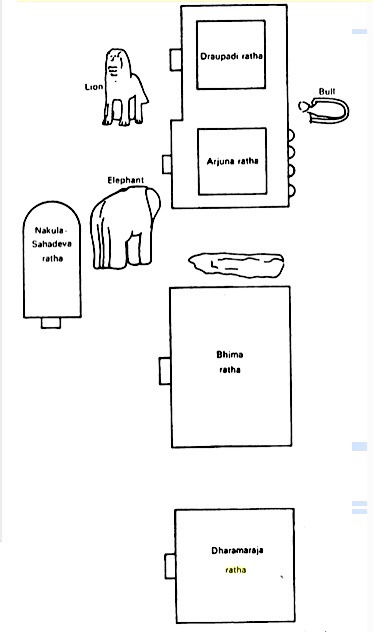
The layout of the Pancha Rathas (from Iconographic reflections on the Arjuna Ratha by Susan Huntington)

These monolithic ‘rathas’ could be experimental models created by the artisans before they actually started implementing these designs and building structural temples. So, here we are possibly looking at an ancient laboratory, where artists experimented with the transition of rock cut temples to structural ones.

Draupadi ratha: this is the smallest and the most elegant among the five rathas in this complex. it resembles a village mud hut with a thatched (curved) bangla chala or Bengal roof. There are four supporting pilasters in the corners, and three niches on three walls that are crowned by makara-toranas. The side facing west has the doorway, with two niches on two sides of the door containing dwarapalikas. The remaining niches show a standing Durga, and the east niche shows Durga standing on the severed head of the mahisasura (buffalo demon). Inside the sanctum, on the wall there is a four-armed standing Durga.
Durga or Kotravai seen with two male devotees (Kabalika sect) kneeling at her feet. One of them has a sword in hand ready to to cut his head off (sacrificial scene, common in Pallava sculptures), as an offering to the devi. There are four ganas watching from overhead. In front of this ratha stands a huge monolithic lion.
Devi’s dwarapalika
Devi’s dwarapalika
Durga, or Vishnu Ammai, as she is better known in Tamil Nadu, on Draupadi ratha wall
Arjuna ratha: Standing on the same plinth as the Draupadi ratha is the Arjuna ratha. Similar in design to the Dharmaraja ratha, though smaller, it is a square structure with steps leading to a shallow pillared mandapa in front. The ratha shows a two tiered superstructure and a hexagonal vimana. While the sanctum is now empty, the four walls are amply sculpted with carved panels between pilasters on four sides. There are five panels on three sides of the main cell with the central one holding prominent figures. The corner-panels show dwarapalas (quite debatable owing to their costumes, postures, and head-gears). One of the central panels (south facing) holds Shiva casually leaning on his Nandi, while the north facing wall holds a young looking Vishnu with his garuda, and Indra on his Airavata stands on the east facing wall. Directly in front of this temple stands a huge monolithic elephant.
Owing to the Indra panel and the elephant in front, the general belief among historians is that the temple was dedicated to Indra. However, according to Susan Huntington, the temple was more likely to have been dedicated to Aiyappan or Aiyyanar-Sasta, the son of Shiva and Mohini. The two women in the left side panel of Aiyyanar-Sasta riding his elephant are his two wives, Puranai and Putkalai. On the right panel we see an older man leading a child, which according to Huntington, are Aiyyanar-Sasta’s son Satyaka and his chief attendant Damanaka.
Vishnu with Garuda on north facing wall
The panels on two sides side of Vishnu and Shiva show a pair of mithuna couples, and two free standing males (whether they are dwarapalas is debatable) in the corner panels. Mithuna couples are also seen in the upper storey kudu panels. There are alternating simhas (lions) and gajas (elephants) carved at the base of this ratha. The decorative patterns used here are kudus and pavilions, similar to that of the Dharmaraja-ratha.
The monolithic bull sitting behind the Draupadi-Arjuna rathas
The group of figures on the east facing wall of the Arjuna’s ratha, which Susan Huntington says is that of Ayyappan or Aiyyanar-Sasta and not that of Indra.
Shiva with nandi

Bhima ratha : it is the largest among the rathas here, with a vaulted barrel/wagon like roof. It is elongated in shape, and stands on a rectangular platform with four pillars and two pilasters on both the east and west sides. The ornamentation seen here are pavilions and false kudus on the upper storey, like the Dharmaraja ratha. The curved roof of this monolith and that of the Draupadi-ratha reminds one of the village thatched huts. There are no figures carved on the walls of this ratha. From its elongated shape it has been derived that the temple was likely to have been a dedication to Anantasayi Vishnu.

East facing side of Bhima ratha
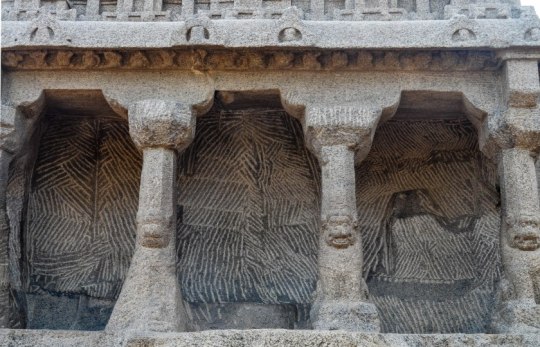
West facing side of Bhima ratha
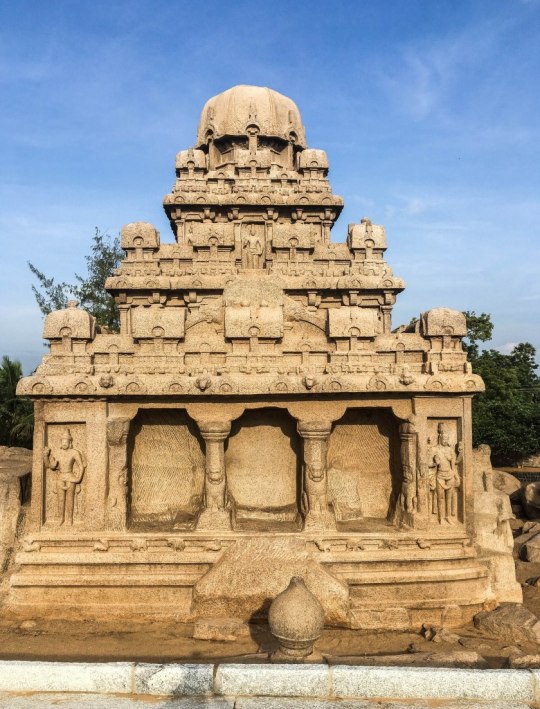
Dharmaraja ratha (east facing side).
The highest temple situated at the southern end of this group is the Dharmaraja ratha. It is pyramidal in shape with a square platform. There are number of diminishing storeys on the upper part, with each storey showing pavilion rows above kudu/chaitya rows. The four corner blocks, have panels that have sculpted figures in them, and between the corner blocks are shallow mandapas with two pillars and two pilasters with simha bases. The eight sculptures on the corner blocks, show Brahma, Harihara, Skanda, one is the royal portraiture of king Narsimhavarma I (identified by the grantha inscribed epithets of the king), three others hold four-armed Shiva, and the last one is a beautiful image of Ardhanarisvara, combining Shiva (purusha) and Parvati (prakriti). The figures in the niches of the central tier are those that would eventually become popular in later temple iconography, such as the four-armed Natesa dancing on Apasmara, Gangadhara Shiva, Vishnu on Garuda, Vinadhara Dakshinamurti, Andhakaasuravadha, Shiva with Arjuna (it could also be Chandesvara or Bharata/nandi), Kankalamurti, Surya wearing karanda mukuta, Krishna on kaliya, Natya Dakshinamurti, along with women figures, devotees, and dwarapalas. There is also a depiction of Somaskanda Shiva on the west facing tier. The pranalas on roof are seen all around the ratha, with human and monkey faces as outlets.
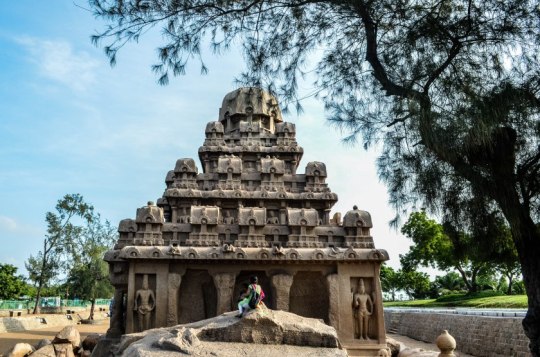
Dharmaraja ratha (south facing side).

Nakula-Sahadeva Ratha: All the temples have a west entrance except the Nakula-Sahadeva Ratha, which has a south entrance. It is apsidal in shape, showing the same ornamentation as in the Arjuna and Dharmaraja rathas. There is a shallow porch in front with two simha based pillars. No carvings of figures are seen on this temple. Besides the temple, stands the huge monolithic elephant, which according to some scholars, is suggestive of the elephant-back shape of the temple.

Krishna Mandapa
This rock cut cave depicts a scene of Krishna lifting the Govardhana hill, known as Goverdhana Uddhara. Here we see Krishna lifting Govardhana with his left palm, in order to protect the cowherds and and their families from the storm created by Indra, while his right hand shows the varada mudra. Near him are the gopis, looking at him in wonder. To his right is his brother Balarama, who is standing with his left hand on the shoulder of a gopa, and right hand on hip. Farther right we see a very natural representation of a cowherd milking his cow, while the cow licks its calf. Another gopi stands near holding milk-pots kept on a rope-sling, while carrying a bundle on her head; and a wood-cutter stands by her with his axe on his shoulder. We also see figures of a mother holding her child, and a cowherd playing his flute, while all around there are cows. The Goverdhana mountain is shown as full of lions, sphinxes, and griffins, at the left side, while an alert bull sits at the other end.



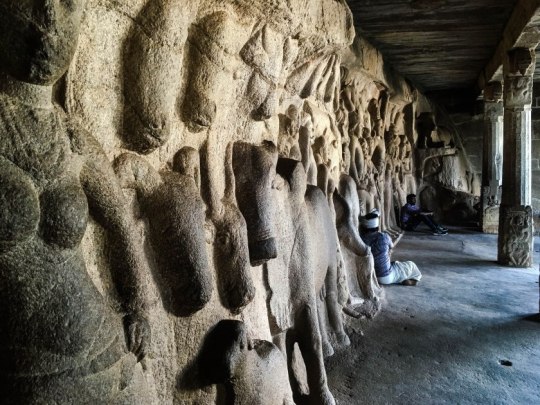


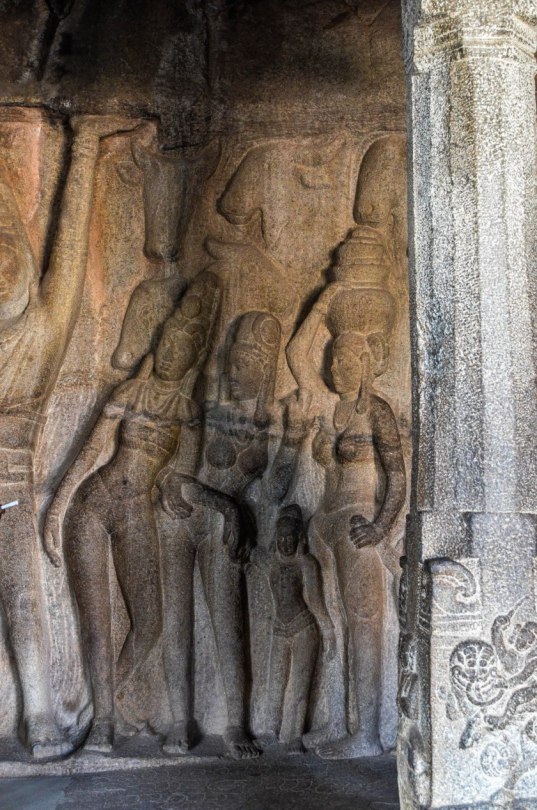



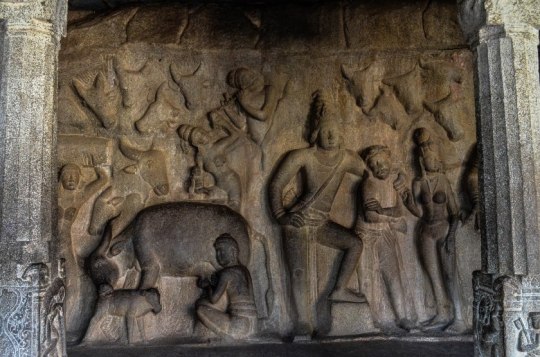
Few other Rock Cut Caves and the Butter Ball

Draupadi’s bath: a small kund holding water in the Mahabalipuram main hill top. (Photo courtesy : Zehra)
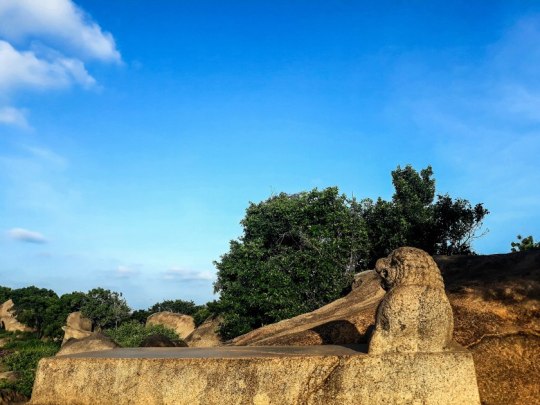
The Dharmaraja rock cut throne. It is a monolithic structure has a large rectangular seat and a lion sitting at one end. This area is believed to have been the main palace site. Seen at Mahabalipuram main hill top. (Photo courtesy : Zehra)
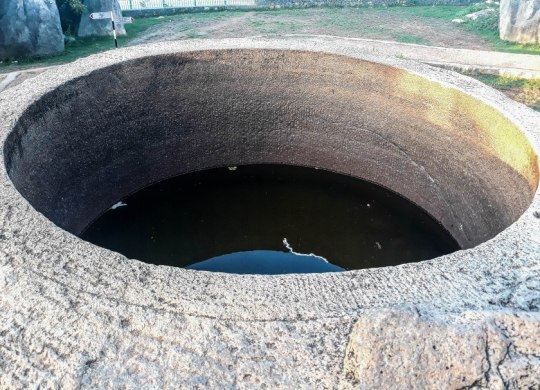
Gopi’s churn. On its rim is seen written ‘Sri-Kadhiti’ in Pallava granth (Photo courtesy : Zehra)
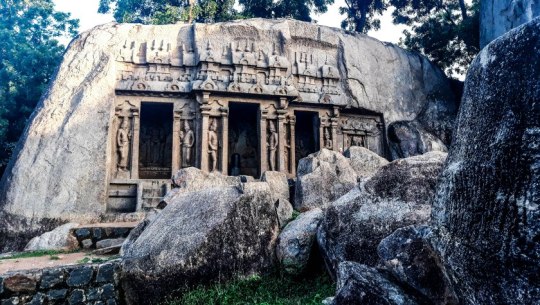
Triple celled rock cut shine of the 7th-8th century (Photo courtesy : Zehra)

Triple celled rock cut shrine of the 7th-8th century. The three cells are dedicated to Shiva (middle cell), Brahma, and Vishnu. Here unusually, Brahma is shown with a single face, wearing a cross mala of rudraksha beads. On his upper hands he holds a kamundala and a japmala, while the lower hands denote abhaya and katyavalambita (also seen in the other two deities). Shiva is shown with an axe and japmala, while Vishnu with his sankha and chakra. The word malla is seen inscribed (script style is of Narasimhhavarman’s period) in Brahma’s cell, which fixes the date of these shrines. Dwarapalas are seen on the entrance niches, while a northern most separate niche holds an eight armed Durga. (Photo courtesy : Zehra)

A beautiful rock cut panel depicting elephants, monkey, and peacock. (Photo courtesy : Zehra)

Ganesha ratha: a three-storeyed structure with a similar roof as that of the Bhima ratha, but of better workmanship. The gable ends of the roof show a human head wearing a trident like head dress. Kudus and pavilions are also present here. The roof shows elaborate designs, and with its nine vase like finials is the precursor of later period south Indian temple gopurams. A row of pilasters decorates the sides and back of the Ganesha ratha, while the temple entrance is on the west. Here we see the dwarapalas in corner niches, along with four lion-pillars and pilasters.

Varaha cave II on the main Mamallapuram hill. Near the Ganesha-ratha and behind Arjuna’s penance is the beautiful Varaha-mandapa. The shallow mandapa at front has four lion pillars and pilasters. The centre garbhagriha behind the pillared mandapa is empty with two dwarapalas guarding the cell. On the sides of sanctum are four wall panels that beautifully depict Gajalakshni, Durga, Varaha raising the bhu-devi from the ocean, and Trivikrama.

The Varaha panel: an unusual depiction of the Varaha avtaar rescuing bhu-devi. Here he is seen looking right and lovingly holding bhu-devi, instead of the typical depiction where he looks left and bhu-devi dangles from his tusk. Among those around him are Surya, Chandra, Brahma, and rishis. The right foot of Varaha is seen resting on Sesha naga. The depiction of lotus flowers and leaves and ripples suggest the presence of water below.
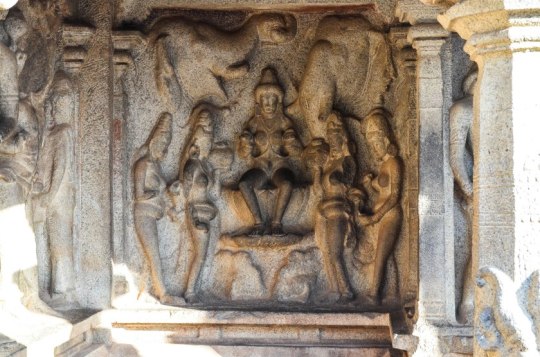
The Gaja-Lakshmi panel: here Lakshmi is seen sitting on a lotus wearing a crown typical of Pallavan sculpture, and a cross garland known as suvarnavaikakshaka, while her hands are suggestive of holding lotuses. The lotus leaves suggest water below. The goddess is surrounded by her female attendants who are carrying water filled pots, while the two elephants are pouring water on her head.
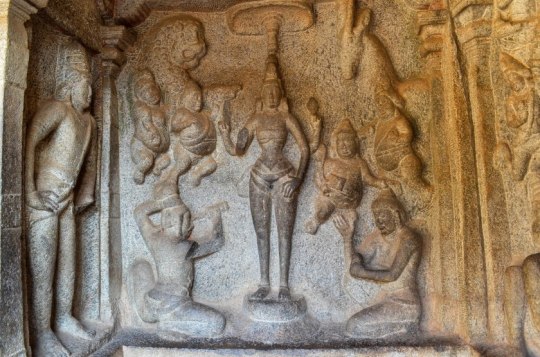
Durga panel: here the devi is shown in katyavalambita and abhaya mudra. The chattri above her denotes her complete sovereignty. On two sides of the devi are a lion, an antelope, ganas, and two male devotees of the Kabalika sect with the one on her right cutting and offering his head (a sacrificial representation).

Trivikrama panel: Vishnu is seen holding a bow, shield, and sword, along with his sankha, chakra and gada. Among the figures present around him are the Sun and Moon, while Bali and his demons are shown at his feet. Brahma and Shiva sitting on lotuses on two sides are also shown as witnessing the event, while on top part we find Jambavan beating a drum in happiness celebrating the defeat of Bali. The figure on left of Trivikrama seen bent and flying in mid-air is likely that of Trisanku, whose space is half way between the earth and heaven. Since the foot of Vishnu reaches above Trisankhu, it denotes his foot has reached heaven.

Rayala gopuram: a little ahead of the Varaha mandapa is an unfinished gopuram of the Vijayanagara period, with their typical jamb decorations. This is the second unfinished gopuram of the Vijayanagara dynasty in Mahabalipuram, the first one being seen in front of the Sthalasayana Perumal temple.

Ornamentation seen on the unfinished Vijaynagara rayala, Ganga on makara

Krishna’s butter ball
Besides the ones mentioned here, and in my previous article, there are many more rock cut caves that are a must visit in Mahabalipuram, which include the Mahisasurmardini caves, AdiVaraha cave, Tiger cave, among others. The main Mahabalipuram hill holds many more caves and unfinished rathas, which are definitely worth seeing. There is also a temple near Mahabalipuram, which came up during the 2004 tsunami and is now an ASI site. Mahabalipuram needs around 2-3 days if one wants to take a detailed look at all the beautiful heritage structures that this ancient city holds.
What to explore in Mahabalipuram (Part II) – The Pancha Rathas, Krishna Mandapa, and other Rock Cut caves The origin of monument building in Mahabalipuram is attributed to the mighty Pallava dynasty that ruled south India from around 3rd century CE with their capital at Kanchipuram, after the decline of their overlords, the Satavahanas.
#ancient#art#buddhism#chennai#culture#hinduism#history#india#mahabalipuram#mamallapuram#pallavas#pallavascript#pancharathas#photography#rathas#religion#rock cut caves#rock relief#southeastasia#tamil nadu#tourism#travel#unescoworldheritagesites#worship
0 notes
Text
satyaka
bden pa gcig po'i le'u'i mdo - Satyaka Parivara Sutra, Chapter of The True One Sutra [RY]
bden pa gcig po'i le'u'i mdo - Satyaka Parivara Sutra, Chapter of The True One Sutra [RY]
0 notes
Photo

Cair nih @whoindonesia @gugustugascovid19 🤭 . Setelah berjuang hampir 3 bulan lebih melawan virus corona atau Covid-19, para tenaga medis akhirnya bisa bernafas lega, karena insentif yang dijanjikan pemerintah sudah cair . Pemerintah memutuskan untuk menyalurkan lebih cepat insentif bagi tenaga kesehatan yang menangani pasien Covid-19, setelah banyaknya tenaga medis yang menjerit insentif buat mereka tak kunjung cair . Kementerian Keuangan pun mengaku sudah menyalurkan Rp 1,3 triliun untuk insentif tenaga medis di tingkat daerah, sampai dengan Selasa (7/7/2020) total insentif tersebut telah disebarkan ke 542 daerah . Direktur Dana Transfer Khusus Direktorat Jenderal Perimbangan Keuangan (DJPK) Kementerian Keuangan Putut Hari Satyaka mengatakan penyaluran insentif untuk tenaga medis sudah tersalur Rp 1,3 triliun untuk 542 daerah . "Kita baru saja menyalurkan per 7 Juli 2020 Rp 1,3 triliun ke 542 daerah," kata Putu dalam konfrensi pers melalui video teleconference di Jakarta, Rabu (CNBC & Suara) . Cc @teluuur @lahatupdate .... .... Follow, like, komentar dan tag temanmu di 1. Follow Ig " @lahatupdate " 2. Follow Facebook " Lahat " 3. Like Halaman facebook " update lahat " 4. Ikuti Twitter " Lahatupdate2 " 5. Subcribe youtube " LahatUpdate " 6. Tumblr " lahatupdate " 7. Workplace " lahatupdate " 8. Bisnisku " lahatupdate " 9. blogger " lahatupdate " Like dan comen di bio kito lor untuk ikut bersama kito terus! Nb : BERIKAN KOMENTAR DENGAN BAIK DAN SOPAN JIKA INGIN MEMBERIKAN SARAN DAN KRITIK. . . #lahat #lahatupdate (di Lahat, Sumatera Selatan, Indonesia) https://www.instagram.com/p/CCtLWBtg1zG/?igshid=ggmc61e8u7kd
0 notes